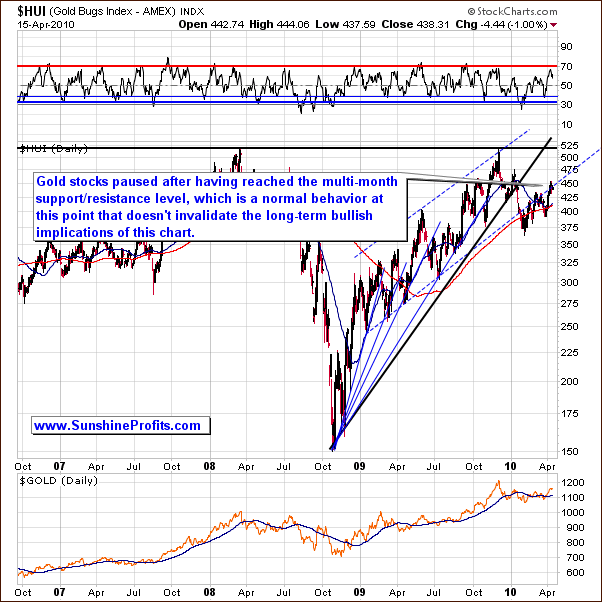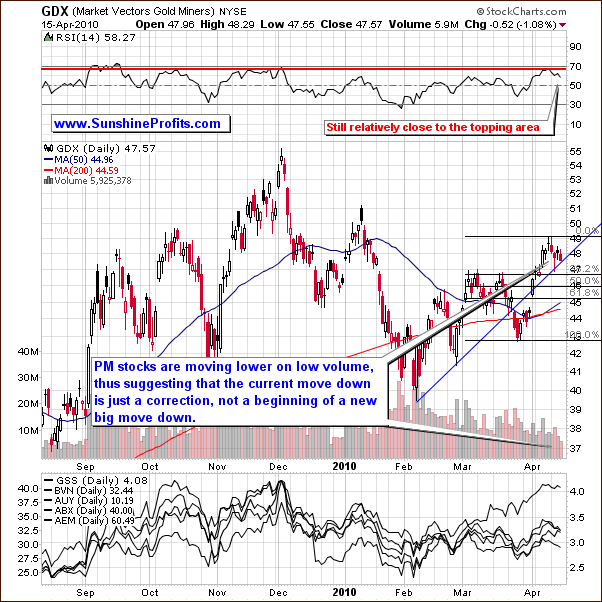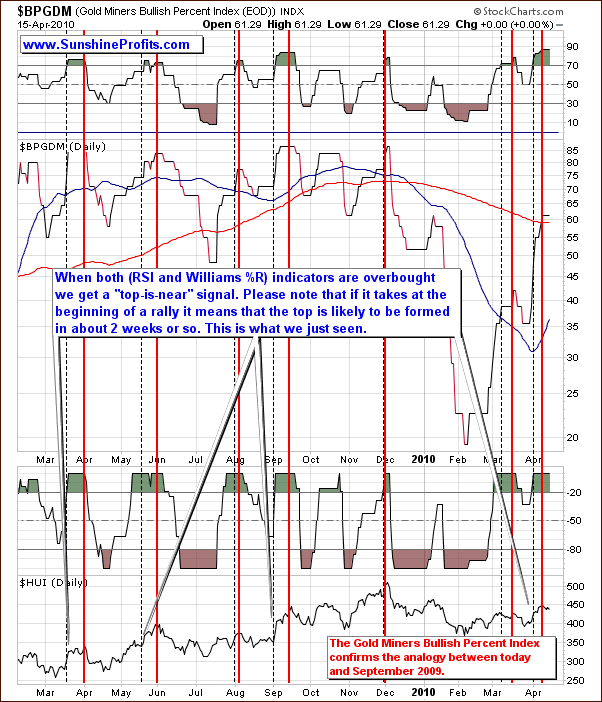This essay is based on the Premium Update posted on April 16th, 2010. Visit our archives for more gold articles.
Prime Minister Gordon Brown, who will face a tough battle in the upcoming elections, has two nicknames in the British press-- "Golden Brown" and "Goldfinger Brown."
Since anything pertaining to gold is of interests to us at Sunshine Profits, we looked into why the Prime Minister has such monikers. Does he perhaps have a Midas touch?
It turns out that quite the opposite is true.
Brown, who took over from Tony Blair in 2007, acquired the ironic nicknames about 11 years ago when, against the advice of leading bankers, he sold off about 60% of Britain's centuries-old gold reserves. The timing of the sales, from 1999-2002, was "impeccable." In his role as Chancellor of the Exchequer he sold 400 tons at rock-bottom prices. He got an average price of $275 an ounce, raising $3.496 billion. (British gold traders have dubbed the 20-year-low the "Brown Bottom.") Since the unfortunate sale, gold prices have more than quadrupled to $1,159 an ounce.
There is a lesson to be learned here both for nations and for individual investors--hold on to your physical gold and don't worry too much about governments selling or "dumping" gold when its price gets very high - history suggests that governments are not the best traders and not necessarily sell at the top.
With only 310.3 tons of gold left in its Central Bank holdings, Great Britain, once an empire that ruled half the world, ranks number 16 on the list of gold-holding nations, just below Venezuela and just above Lebanon.
There is further irony in the fact that it was Britain that had led the way in establishing a gold standard when Sir Isaac Newton, as warden of the Royal Mint, linked the value of raw gold to the value of money back in 1717. The 1844 Bank Charter Act formalized the gold standard, the Bank of England's promise that every note could be redeemed for its value in gold. The gold standard lasted until Britain was forced to abandon it during World War I. Churchill returned to the standard in 1925 but it was again abandoned in 1931.
Newspaper accounts in the British press estimate that Brown's gold sale cost the British taxpayer about 6 billion pounds.
The gold sale has become a campaign issue and already posters have appeared of a smiling Brown with the accompanying text: "I lost 6 billion pounds selling off Britain's gold. Vote for Me."
According to British newspaper reports, the proceeds from the gold sale were invested in dollars (40%), in euros (40%) and in the yen (20%). It is safe to say that the revenues generated from the fiat currencies don't come close to the spectacular four-fold increase in the value of gold since the sale.
In May of 1999, when Brown announced his plans to sell the gold, the price had stagnated for much of the decade in a secular bear market. British gold simply sat in the vaults gleaming prettily but earning no interest. Some had perceived it as a capital wasteland, an anachronistic relic. Apparently, Brown wanted assets that would generate interest payments. He ignored gold's habit of retaining its intrinsic value over the long term.
"Golden Brown" was wrong to dump gold in favor of paper currencies.Gold's breakout against the world's primary paper currencies underscores gold's growing allure as a store of value against further currency debasement caused by profligate government spending. It appears that gold is reassuming its role as an alternative currency unencumbered by the political liabilities of fiat money.
Therefore, the long-term bullish fundamentals are still in place despite the fact that governments still own a substantial amount of gold - they are not super-traders, who are likely to sell everything at the top, thus pushing prices lower. Still, fundamentals are responsible for where markets go in the long-term (years), not where they may go in the short- and medium-term (days, months). Therefore, let's focus on the charts (charts courtesy by http://stockcharts.com) and see what they tell us at the moment.
In the following part of this essay, we will focus on the situation in the mining stocks, as it seems that there are several voices saying that the rally in gold stocks is over and they are likely to decline from here - we respectfully disagree.

In one of the previous commentaries, we've stated that though sharply moving higher recently, [HUI Index] appears to be ready to pause, especially, as the multi-month support level has been touched. Consequently, the current pause is something natural, not necessarily a signal of a coming plunge. One of the questions at this point is - are prices likely to move much lower?
Let's take a look at the short-term GDX ETF chart, which we use as a proxy for the PM stocks.

Only a few days ago the chart suggested that we were to expect the resistance level of 49 to hold as the upper point with an expected support at $47 and even more likely $46. The above levels were based on the Fibonacci retracement levels, which have proven to be a very reliable signal as far as the precious metals stocks are concerned. Consequently, the recent move lower is something that one would expect to see as a part of a bigger rally, and doesn't seem to signal a severe plunge.
Additional confirmation of the above points comes from the analysis of the Gold Miners Bullish Percent Index - a market breadth/momentum indicator that is calculated by dividing two numbers: the amount of gold stocks on the buy signal (according to the point and figure chart, which emphasizes strong moves while ignoring small ones) and the amount of all gold stocks in the sector.

We have featured the above chart also in the April 2nd, 2010 Premium Update, when we wrote the following:
The high-probability sell signal is given if this index moves higher, and both indicators (RSI and William's %R) used on the above chart become, and then stay overvalued for some time. The initial overbought signal is marked with the vertical dashed black lines, and the top signal is marked with red lines. The overbought signal was given several days ago, so the probability that the top is already in is relatively high.
Still, taking a more detailed approach, we see that if we get this signal at the beginning of a rally, the top is likely to be formed in about two weeks. That was the case about a year ago, in May/June 2009, and in September 2009.
Consequently, we have just seen a local top, which - once again - was something that was likely to take place and does not necessarily signal a severe decline at this point.
Summing up, while the first part of the rally in PMs and corresponding stocks is over, there are no clear signs that the whole rally is over at this point. Comments regarding short-term, and action that we believe is best to take at this point are available to our Subscribers.
To make sure that you are notified once the new features are implemented, and get immediate access to my free thoughts on the market, including information not available publicly, I urge you to sign up for my free e-mail list. Sign up today and you'll also get free, 7-day access to the Premium Sections on my website, including valuable tools and charts dedicated to serious PM Investors and Speculators. It's free and you may unsubscribe at any time.
Thank you for reading. Have a great weekend and profitable week!
P. Radomski
--
The precious metals continue to trade sideways, while USD Index appears to have put a temporary bottom and the main stock indices continue to soar. What are the implications for Gold and Silver Investors and Traders? When is this correction going to end? What is likely to happen in the next few days? These are just a few of the questions that we have dealt with in this week's Premium Update and the following Market Alert.
This nearly 5000-world long commentary includes the in-depth analysis of the current situation on the metals market with suggestions on what action it would be best to take right now, given what is likely to take place in the following days/weeks.
The analysis includes: 3 charts dedicated to the USD Index, 3 charts dedicated to the main stock indices, 2 gold-, 2 silver-, and 2 mining stock charts along with the analysis of the Gold Miners Bullish Percent Index. Additionally, we've covered our correlation matrix, and two very recent signals from our unique indicators. We encourage you to Subscribe to the Premium Service today and read the full version of this week's analysis right away.

